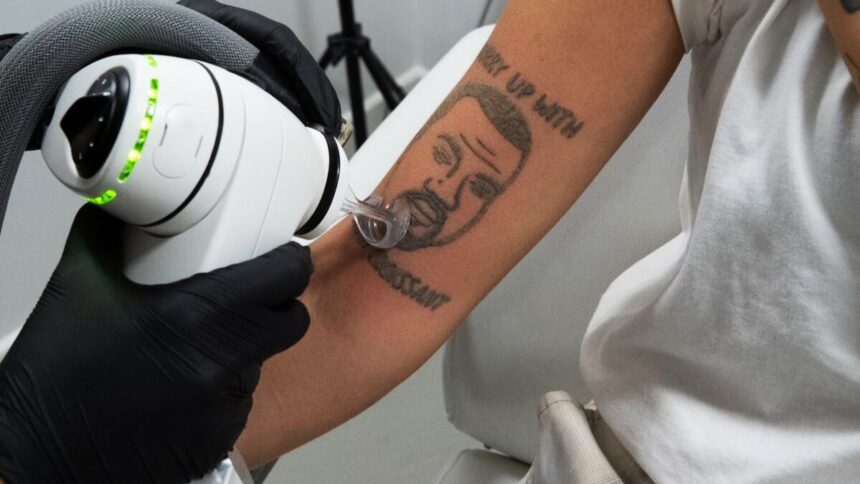Removing a tattoo is a multifaceted process that requires careful consideration and adherence to specific protocols to achieve the best results while minimizing risks. Here’s an in-depth look at the entire tattoo removal process, from precautions and methods to aftercare.
Essential Precautions During Tattoo Removal
1. Clean Environment
- Importance: A clean environment is crucial for preventing infections and ensuring the success of the removal procedure.
- Action: Select a medical institution or clinic that has a solid reputation for upholding strict standards of cleanliness and hygiene. Make sure the area is clean and clear of pollutants before beginning the treatment.
2. Safety Equipment
- Gloves: It is recommended that both the technician and the customer use disposable gloves. They guarantee a sanitary atmosphere and guard against contamination.
- Protective Goggles: Goggles are required for both the customer and the technician. The client’s goggles provide protection from inadvertent exposure to the laser, while the technician’s goggles shield their eyes from it.
3. Sterilization of Equipment
- Importance: Proper sterilization of all equipment is vital to prevent infections.
- Action: Prior to usage, make sure that all instruments, including dermabrasion tools and laser handpieces, have been properly sterilised. To do this, autoclaves or other sterilizing techniques are typically used to get rid of germs and viruses.
4. Skin Preparation
- Importance: An infection can be prevented and the removal process can be carried out more successfully with proper skin preparation.
- Action: The technician should use an antiseptic solution to clean the region and get rid of any dirt, oils, or bacteria before starting the operation. This step improves the removal process’s effectiveness and lowers the possibility of problems.
This tattoo removal @helltattoo pic.twitter.com/JspyYCURjB
— JD’s vision (@Upliftingvision) August 14, 2024Detailed Tattoo Removal Process
1. Evaluation
- Purpose: To customize the tattoo removal procedure to the unique features of the design.
- Action: The technician will assess several factors, including:
- Size: Larger tattoos may require more sessions.
- Color: Different colors may respond differently to various lasers.
- Depth: The depth of the ink in the skin affects how it’s removed.
2. Choosing the Removal Method
- Options Available:
- Laser Tattoo Removal: The most common and effective method, using lasers to break down the ink particles in the skin.
- Surgical Excision: Involves cutting out the tattooed skin and stitching the remaining skin together. Suitable for small tattoos.
- Dermabrasion: A technique where the top layers of skin are sanded off to remove the tattoo. This method can be more abrasive and may require a longer healing time.
- Chemical Peels: Uses chemical solutions to exfoliate the skin and remove the tattoo. This method is less commonly used due to potential side effects and varying effectiveness.
- Protective Glasses: Ensure that both you and the technician wear protective eyewear to prevent eye damage from the laser.
- Laser Application: The laser emits light at specific wavelengths to target and break down the ink particles in the skin. Different wavelengths are used depending on the ink colors.
- Post-Treatment Care: After the procedure, the area is often covered with a sterile dressing or treated with an ointment to aid healing and prevent infection.
Number of Sessions Required
- Typical Duration: In most cases, several treatments are needed to completely remove tattoos. In order to give the skin time to recover between treatments, sessions are usually separated by several weeks.
- Factors Influencing Sessions:
- Tattoo Size: Larger tattoos take more time to remove.
- Ink Color: Some colors, especially darker shades, may be more difficult to remove and require additional sessions.
- Ink Depth: Tattoos with deeper ink placement may require more treatments.
Comprehensive Post-Tattoo Removal Care Tips
1. Protect from Sunlight
- Importance: Sun exposure can lead to hyperpigmentation or other skin issues.
- Action: Keep the treated area covered with clothing or use a high-SPF sunscreen to protect it from UV rays.
2. Keep the Area Clean
- Importance: Proper hygiene helps in preventing infections and promoting healing.
- Action: Using a little soap and water, gently clean the treated area. Avert using products that are strong or smelly since they may cause skin irritation.
3. Apply Ointments
- Importance: Ointments help to soothe the skin and promote healing.
- Action: Follow your technician’s instructions while using any suggested or prescription ointments. These might be moisturizing lotions or antibiotic ointments to stop scabbing and encourage skin regrowth.
4. Avoid Scratching or Picking
- Importance: Scratching or picking at the treated area can lead to scarring and complications.
- Action: Let the skin heal naturally. If you experience itching, use prescribed creams or over-the-counter anti-itch medications to alleviate discomfort.
5. Follow-Up Appointments
- Importance: Regular follow-ups ensure that the removal process is progressing as expected and allows the technician to address any concerns.
- Action: Attend all scheduled follow-up appointments and communicate any issues or side effects to your technician promptly.
You can make sure that your tattoo removal procedure is as efficient and risk-free as possible by following these comprehensive instructions, which will also help to maximize recovery.
Read More: Boost Your Skin Health with These 7 Vitamin K-Rich Foods






